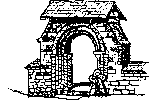Stane Street in Upper Morden
 Local History Notes 3: by W J Rudd
Local History Notes 3: by W J Rudd
In the autumn of 1963, construction works were carried out by Post Office Telephones for a new service chamber in the public pavement of London Road near the entrance to Morden Park. The opportunity was taken by the writer, in the brief time available, to examine and photograph the excavation before construction commenced. Chalk and flint layers appear to be authentic remains of the Roman road now known as Stane Street.
Click on the image on the right to download a free pdf of this publication.
Extract from the Introduction
MERTON HISTORICAL SOCIETY
LOCAL HISTORY NOTES –
Stane Street in Upper Morden
by W J Rudd
3 LOCAL HISTORY NOTES –
Stane Street in Upper Morden
by W J Rudd
3
Morden Park House is served by a driveway from London Road which is now utilised
also for the Merton Technical College and the Swimming Baths. A Lodge Cottage
stood on the south side of the entrance until it was demolished and replaced by the
present ‘plastic box’. In the autumn of 1963, construction works were carried out
by Post Office Telephones for a new service chamber in the public pavement of
London Road near the Lodge Cottage. The opportunity was taken by the writer, in
the brief time available, to examine the excavation before construction commenced.
The chamber, boxed in by a board screen for safety, measured approximately seven-
foot by five-foot by seven-foot deep. It was possible to examine all four sections,
and photographs were taken, but it was not possible to make detailed drawings.
On the north, west and south elevations a particular feature was observed, a flint-
chalk-flint layer. It extended some two-thirds across the north elevation and the whole
of the west and south elevations. It was at a maximum thickness of some two feet
but was extremely variable, particularly the thin chalk layer. A selected part of the
three elevations was measured from the surface level, and are approximate. The west
and north are recorded on the plan.
Clearly, the feature is man-made, and forms a laid-down surface. More important,
when plotted on a map it falls into line with the discoveries made by Dennis Turner
in 1958/9 in his exploratory excavations for the Roman Road in Morden Park. It is
at some depth from the pavement level and this would probably account for the fact
that Dennis Turner failed to find it in the back garden of Lodge Cottage; though it
did appear as a gravel layer between one and two feet in two trenches in the back
gardens of Morden Park Cottages (now demolished). The Roman engineers would
have used local available materials – gravels, flint and chalk – and the Road may have
required some repair from time-to-time. In the centuries that followed it finally broke
down but survived locally as part of the Parish Boundary over Stonecot Hill and
Epsom Road.
W J Rudd February 1990
The POST OFFICE TELEPHONES square access cover in
the pavement outside Lodge Cottage in the Spring of 1964
London Road by Entrance to Merton Technical College – 1973
Post Office Telephones – new chamber excavation – Autumn 1963.
West and North faces
West face South face
One point on the centre line of Stane Street seems almost certainly defined by the
square access cover of the POST OFFICE TELEPHONES chamber in the west
pavement of London Road about fifteen metres south of the driveway to the
Technical College (TQ 25075 67665). This lies about twenty-five metres from the
nearest point (TQ 25095 67650) on the alignment of Stane Street as presumed by
S E Winbolt MA and by I D Margary MA and shown on the strip map in Margary’s
book “Roman Ways in the Weald”.
As viewed and described, these layers in the excavation laid on undisturbed London
Clay appear to be authentic remains of Stane Street, but absolute proof requires that
the length of the section should be at least 6.7 metres – the usual width of carriageway
-at right angles to the alignment of the road, which was not possible at that juncture.
Furthermore no accredited person could be found to inspect and corroborate this
feature during the short time available, and that explains the reluctance to publish, but
no member of Merton Historical Society will doubt Mr Rudd’s veracity.
Excavations during 1959 in Morden Park about 130 metres distant from here,
reported in The London Naturalist No.39 p.130, were fraught with difficulties and
were not entirely conclusive, whereas the excavations in Lower Morden in 1958
produced good evidence. All these archaeological vestiges are close to the direct
bearing from Colliers Wood High Street to Stonecot Hill summit.
Any future research in this area undoubtedly will be greatly assisted and guided by
the knowledge and information from this archaeological discovery.
C E Sole March 1990
ISBN 1 903899 27 3
Published by Merton Historical Society – January 1991
Further information on Merton Historical Society can be obtained from
Merton Library & Heritage Service, Merton Civic Centre, London Road, Morden, Surrey. SM4 5DX
REFERENCES:
D J Turner MA The London Naturalist No.39 p.130 (1959)
D J Turner MA The London Naturalist No.38 p.22 (1958)
I D Margary MA “Roman Ways in the Weald” Phoenix (1965)
S E Winbolt MA “With a Spade on Stane Street” Methuen (1936)
 MERTON HISTORICAL SOCIETY
MERTON HISTORICAL SOCIETY